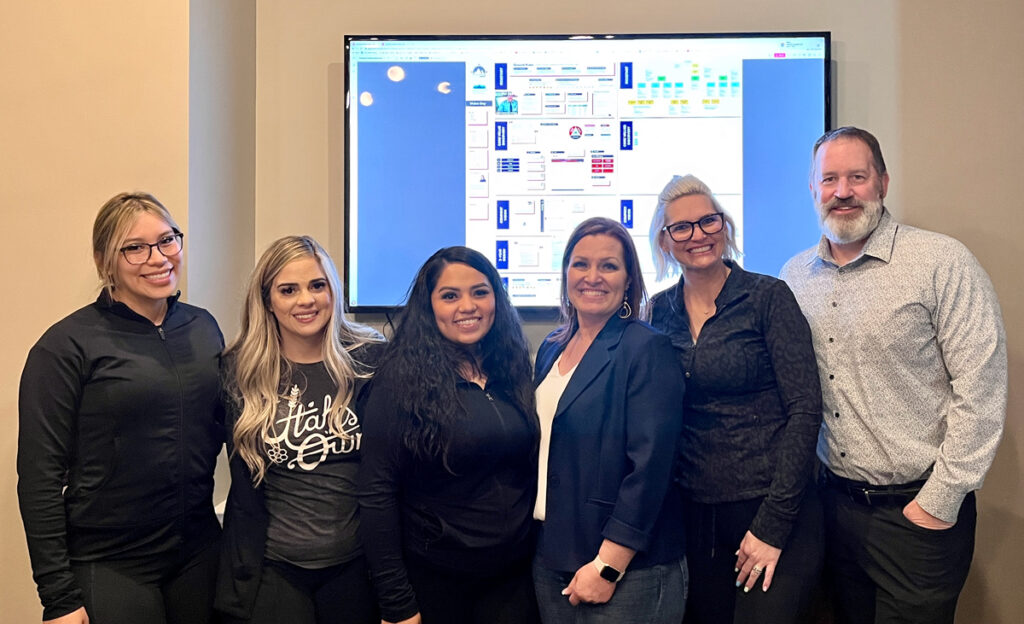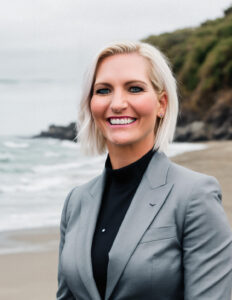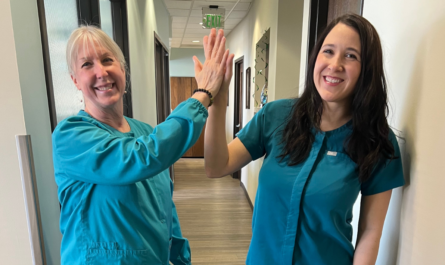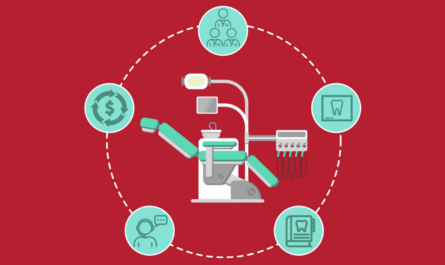Frandsen Dental’s Tiffany Fleisch has seen how strong systems can lead to transformational growth.
For Tiffany Fleisch, both individual and organizational growth has meant leaning into, rather than avoiding, frustrations. “I think frustrations lead to breakthroughs,” said Fleisch, Director of Operations for Utah-based Frandsen Dental.
Leaders must be OK with trying something out, and if it doesn’t work, going back to the drawing board. “I really don’t have a problem in just throwing an idea out there and testing to see how it works.”
That mindset helped Fleisch when she jumped from being a dental assistant to a practice leader (office manager) during an economic downturn. It helped as her organization completed two mergers a decade ago (six weeks before she had a baby). And it has been key in navigating a disruptive marketplace over the last few years.
Fleisch isn’t afraid of frustration because she’s got a secret weapon to combat it – systems. She is a big believer in using systems to try out new ideas and concepts to see how they could make things better for team members, clinicians and patients. “I don’t do things the same way I did even two years ago,” she said. “There’s always so much more to learn, do, implement and try.”
In a conversation with DEO Magazine, Fleisch discussed how she measures success beyond numbers, and how systems have led to incredible gains in efficiencies for her clinicians and team members.
| How to Create Repeatable Systems If systems aren’t repeatable, then they’re not working for you. The following are three steps to follow: Step No. 1: Identify. The first step is to identify what core systems you need to implement. Sometimes dental leaders have a big list of all of these systems that they feel are needed. However, you probably only need a handful to get started. Here are four critical systems to consider for a dental practice to run well: Team culture Patient experience Revenue cycle management Project management Step No. 2: Document. Once you identify the core systems, you will want to document them. Keep it very, very simple, using a chronological or linear approach to identify key milestones, benchmarks and KPIs along the way. Step No. 3: Package. After you identify and document, put some visuals together for your team. Package it in an appealing, easy-to-read format. It almost becomes like a little franchise template for your way of doing business, and this is the book that your organization will work from. Systems don’t have to be boring. Even a clinical standards manual can be engaging if done right. |

DEO Magazine: As a Director of Operations, how do you measure the success of your organization?
Fleisch: We like to look at what we did in the past, because if you investigate today or the future, you’re going to constantly feel like there’s too much to do. I have lists and ideas for days of all the things we need to do or what’s not perfect yet. But every quarter when we get together with our team, we look at all the things we were able to accomplish, even minor things, and that’s been helpful. You don’t realize how impactful those accomplishments are until you come back and reflect on them. It gives us more steam to know that we’re on the right track.
I look at profitability more today. For example, our revenue hasn’t crept up the same year-over-year that it has in the past, but our profitability is the best it’s ever been. That is a success, because we’re actually getting smarter and leaner with our expenses. You must be patient enough to hang tight to see that what you’re doing is working.
DEO: You’ve talked in the past about the benefits of using systems to help your organization’s cultural growth. But what about the overall benefits?
Fleisch: I love systems. Systems is my love language. You want to plot an Excel sheet and show me a system? That makes me really happy.
Today, we’re constantly trying to simplify our systems. How do we make them easier for the end user, my team members? For my team, I want it to be an easy part of their day. I don’t want to stack a bunch of things on them. When we create a system, how do we take 20 steps and cut them down to five? We’re constantly trying to look for efficiencies in our systems that make it easier for the team overall. You can always shiny new things to stack on, but what I get really excited about now is, what can I take off?
Doing that with automation helps combat brain fatigue and decision fatigue that my team has to deal with all day long. How can I automate processes and make it easier for them?
You’re never done. When we first started this journey, I thought it would take a year to build our systems. That was eight or nine years ago. Some of the foundational systems we still have are ones I come back to and ask myself, “How do we make that better? How do we take out some of that noise?” So, I think when you realize it’s never over, that makes it fun to go back and do it all over again. We get to blow it up and we get to put it back together in a nice, pretty bow.
DEO: What areas have seen the most improvement over the last few years?
Fleisch: We’ve done really well in helping our practice leaders identify their problems on their own. Instead of me having to be the one to say, “Hey, your numbers aren’t where they need to be,” they’ve been able to come to our weekly meetings and say, “Here’s where my problem is and here’s what my solutions are, and what I want to go do and try.” So that’s been one great thing about the systems.
The other area is training and onboarding. Whenever we have something new that comes out, whether it’s a new software or technology, we’re constantly asking “How do we roll this out to the test with part of the team? How do we roll this out to our entire team? Where does that go in our onboarding and training and development?”
These systems have created a way to plug and play information in different places, and then also have resources for team members when they’re not in training and they need to just quickly grab that information. They have it at their fingertips instead of having to go dig for things.
I think now my team is used to me challenging the systems. We’ve been able to take certain systems and I’ve been open enough for them to give me their feedback and show them that, when they do give me that feedback, I’m not going to push back on them because it’s my system. I’m going to agree with them, and I’m going to push them even further to say, “Hey, shrink it down even more.”
I get asked all the time how my team is constantly coming up with new ideas. Well, they’re just used to a “let’s try it” mentality, because they know if we try it and it doesn’t work, I’m open to scrapping it and moving on. My team has been amazing at implementing and giving feedback of what’s working and what’s not.
Last year, we started to reduce our PPOs, the insurances that we were in. We’re constantly monitoring our insurance reimbursements. If we’re jumping out of insurance or taking fewer PPOs and that is raising the fees in our practices, we’re trying to find ways to make it more affordable for our patients. So, we are looking at different patient financing options. We don’t want to become a bank, but we also see that people need payment plans if they’re going to be able to complete their treatment.
And there is always the tech stack. Whatever tech we can find that’s going to help reduce noise for the team, not just add another software. It must have an end goal and save the team on efficiency, not just be new, cool and shiny.
| When You Don’t Have Systems When you don’t have systems in place, three things happen. First, you are constantly recreating the wheel. During COVID, a lot of dental organizations were surviving without any systems and counting on having experienced knowledge when an individual was hired. Leaders were assuming that because the last person had a skill or experience, they would pass that on to the next team member who took over. But what if they didn’t? What if your dental practice is in an area with high turnover, such as a seasonal location or military hub? Several times a year you may have to hire and train new team members. Having a system in place for this allows you to get off the hamster wheel and stay ahead of the problem. It also means you won’t be held hostage by a toxic team member that has a ton of institutional knowledge but is hurting your organization otherwise. Second, if your results are inconsistent, or if you feel like you’re putting in a ton of work but not getting the results or the outcomes that you need, it’s probably because you don’t have great systems. Further, if team member A, team member B and team member C have a high discrepancy in their performance and what they’re doing, you probably don’t have a system in place. If you do have a system, you’re not training to it and holding people accountable. Those are the two pieces of the puzzle. Do you have a system that’s effective and are you actually holding people accountable to performance of that system? One of those things is absolutely broken if you’re in that scenario. Third, if you have a team that is overwhelmed, burned out or confused, or the team is just not doing things in the ways that you would expect, it’s probably also a system’s issue. When building an annual or quarterly plan, many dental organizations will have training as the top priority. But if you ask the leader what problem they’re trying to solve with training, can they answer? You have to have something to train people on. Let’s simplify and create the systems and train them to the systems. It becomes a lot easier than just trying to train, train, train. Chances are you may not need training; you need better management and better systems. |
DEO: How do you create benchmarks for evaluating technology?
Fleisch: I’ll get the information from the company and, instead of rolling it right out, I put it on the shelf for a minute and then come back to it later on and ask, “Is it as exciting to me now as it was the day I did the demo?” Then we may roll it out a practice or location at a time instead of just throwing it on the entire organization.
You’re always going to get a salesperson who’s trying to sell you on all the great things that it does, but are they going to open up the curtain and tell you the things it doesn’t do? So that’s one of the questions I always love to ask, “What are the capabilities that your software can’t do?”
What did the tech replace for my team? Does it actually save them time? If it doesn’t, then we’re able to cross that one off the list. We don’t roll it out. Or we’ll look at our current software that we have and find out, do they have features in there that we’re just not utilizing?
It comes back to feedback. We will ask our practice leaders with new tech, where is it working and where is it not working? Then evaluate from there.
DEO: What do you think are some of the biggest challenges for dental group practices? What’s keeping leaders up at night as we head into 2024?
Fleisch: There’s always the unknown when things start to slow down. I became a practice leader in 2008 because of the economic crash, and it felt like it happened almost overnight. I was a dental assistant and then all of a sudden, we didn’t have patients. Today it has been working through all the different things with inflation and trying to compete with people’s dollars.
But you can’t lose sleep over the unknown. You just must keep pushing forward and asking, “Are we doing the things that are really going to create the most impact? Are we helping out the patients? Are we helping out the team?”
Am I making it easier for my patients to do something, whether it’s consent forms or payment plans? Am I making it easier for my team to have fewer steps? I think those are the things that are going to help us in the end. But yeah, what keeps us up at night is always that unknown of what’s coming into next year.
We still have lots of burning fires. If everything was rainbows and unicorns, that would be amazing, but I think a few burning fires are kind of fun. It keeps it spicy. You don’t get bored. You can say to yourself, “All right, let’s put on our parachute, jump in, and go fix it.”
| Principles of Strong Systems The DEO has identified seven principles of strong dental systems: No. 1: Strong systems are simple. There might be some type of visual component to the system, because when we see something visually, it allows us to understand it much faster. How can you break it down more? How can you simplify it to just the very necessary points? Can you remove a step and get the same outcome? If so, do it. The step was no longer necessary. No. 2: Strong systems are adaptable. Whether that means you must make a slight adjustment because technologies changed, or you have to make a massive adjustment because some external circumstances shifted, a strong system adapts. Whatever it might be, you must think of your system as something that is constantly evolving. That’’ a great way to keep your teams engaged in what’s happening when they feel like they have ownership over the system and the ability to make it better. No. 3: Strong systems promote efficiency. If they don’t, what is the point? You should continually seek ways to save time and energy and make things easier for your team. Also remember that efficiency comes from minimizing waste. If we can decrease the amount of thought process that goes into things so team members know immediately what to do, that helps save so much energy. No. 4: Strong systems are integrated with one another. They should not be counterintuitive. Rather, they should integrate and support one another. No. 5: Strong systems are transparent and easy for people to understand. Don’t make things super complicated. Complexity dilutes the power of systems. Dial things back to just the core pieces that are understandable for everybody. No. 6: Strong systems are scalable. They should serve you today, and tomorrow. You shouldn’t have to be recreating the wheel every time you add a new person or have an increase in patients or locations. No. 7: Strong systems are user-centric. The last thing to consider is that the systems should be built around the people that are operating them. So often we think about it as our end customer of the system is our patient. We actually need to focus on the individual that’s operating the system, that they’re able to do it effectively, comfortably, and that they can also be at the center of the experience to make sure that they are watching what’s going on, seeing the end result, and have the ability to see when perhaps maybe we’re not getting what we expected out of the system. |







